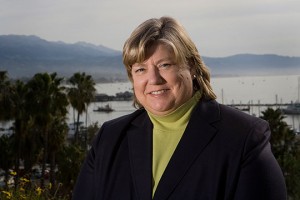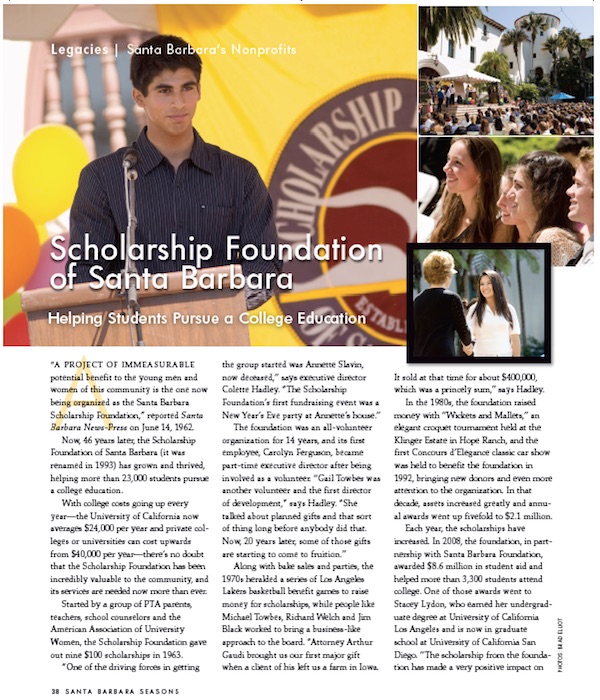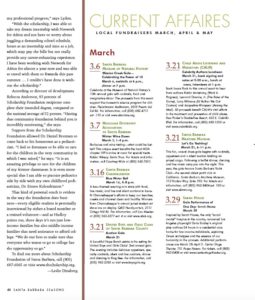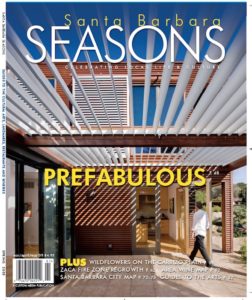Colette Hadley’s Commitment to Education Is All About Opportunity
Leslie Dinaberg: How long have you been at the Scholarship
Foundation of Santa Barbara?
Colette Hadley: Seventeen years. I started here when I was 30
and I’m 47. The foundation and I, funnily enough, were born on the same day. May
29, 1962 was the first meeting of the scholarship foundation and that’s the same day
I was born.
LD: Fate.
CH: I like to think of that a little bit as the kinship between us.
I’ve been here a long time. I started out doing, interestingly enough, some event
management and then within a year moved into program management. We were
just a tiny group, there were like four employees. We’re still small but we were
really small.
LD: Did you come to Santa Barbara to do that or were you
already here?
CH: I’m a pretty planned person in life. … I actually had worked
at the University of California at the Irvine campus and then a little bit at the UCLA campus in student affairs, and I was just kind of looking for a change. … I really liked higher
education, working with students, but I really wanted to see more of the results of
what I was doing. I wanted to be a little more hands on. I loved my work there but …
I felt like I was like kind of a cog in a big university, which I was, so I wanted to do
something smaller. I specifically said I’m going to look for an educationally related
job, most likely a nonprofit.
… I had a friend from college living in Santa Barbara and we had kept in close touch.
She said, “why don’t you come check out Santa Barbara and stay with me for a
couple of weeks.” This was in 1992 and I said “there are no jobs in Santa Barbara,
everybody knows there are no jobs in Santa Barbara, and so I’ll just come and sit on
a beach.”
LD: And you found the job through a tiny newspaper ad.
CH: I sent them my resume and they called me. … I had this
interview scheduled at the University Club and they really hadn’t told me much about it. So I go into this little room at the University Club and there are eight people in this room and I’m thinking I was just going for a one-on-one interview. I go in, I just shook the sand out of my sandals and pulled on a skirt and put on a jacket … and I walked in this room and it was full
of very warm, smiling people. … I’m looking at people who are just big circles of
warmth. … So I sit down and they’re like we’re so glad to meet you and we’re so
excited and tell us about this and tell us about that and we just sat and had a
conversation and I just instantly liked them.
… I had been home five minutes and the phone rang and it’s Billie Mans (former
executive director) and she goes, “we loved you!” Nobody does that. They say, “Oh
we’d like you to come back for a second interview.” She’s like “we loved you come
back again. We want you to meet some more board members.”
So I go back again. I’m thinking geez these people really care. They have all these
board members and the staff and they really care.
LD: What a change from a huge university. Not that they don’t
care, but there are just so many layers.
CH: Basically I went back and they offered me a job. … I had to
decide whether I wanted to take a pretty significant pay cut. But the gut was I would
enjoy working with these people. We had nothing written down or anything but
they said I’m telling you within three years you’ll be back to what you were making
and beyond that. And we promise that if you decide you want to be here and you’re
committed and you do this job that we will be here for you and I just trusted them
and they did that.
LD: That’s great.
CH: Good people. So I had good mentoring with Billie and we
kind of grew along together and good mentoring with the board and you know since
that time we’ve been that way, 17 years later, and that’s why I’m still here.
LD: When did you become the executive director?
CH: Four years ago. I worked as the program director for quite a
long time and then as the associate director. … I’m very fortunate. I still think I have
probably the best job in town. Maybe me or Ron Gallo
(executive director of the Santa Barbara Foundation), I’m not sure. Maybe me.
(Laughs)
LD: There are a lot of similarities actually.
CH: Yeah. He’s got a great board and we actually share some
people on the boards, so for me that’s the fun though. It’s great students and parents
and great board members and great staff but also really we have great donors. … It’s
something that keeps me very connected to my work.
LD: That’s great. Are most of the big supporters people who were
scholarship students at one point?
CH: Excellent question. I would say that at least half of them.
They all have a personal story … Some people have also said the opposite: they grew
up with a supportive family environment and they had the resources to send me to
college and they went to a phenomenal university and have then gone on to achieve
quite a bit in their life and then said you know what, I am really aware that there are
people out there that did not have that and it’s not an equal playing field. And so it’s
my obligation to help, that’s an attitude we run into, besides the people that say oh
yes, I couldn’t have gone if I didn’t have a scholarship.
… The stories are amazing and some of them you don’t know until years go by, and
you don’t know. So yes, that’s part of it too. I think it doesn’t matter what nonprofit
you work with or what you do. It’s about the stories. It’s about that. You probably
find that in your work too.
LD: Oh yes, it’s about the stories for sure.
CH: It’s the same thing with the parents of students, it’s their
stories, that’s really what it’s about is that connection. That’s why introducing
students or having them speak at something or tell their story, we can all find some
connection there.
LD: So is it tougher to get into college now?
CH: I will give you the stats I know. Basically the peak of the baby
boomlet, the kids of the baby boomers, was really this last year, so in sheer numbers
competing for seats, the peak was last year. It’s still high right now but it will start to
diminish. … Santa Barbara County, especially in the south county, our population of
high school seniors will start to slowly go down and so that’s happening all over the
country a little bit. So they will actually have a little less competition for seats in the
next couple of years.
However, what has offset that because we have such a bad budget situation is that
last year all of the UC’s and Cal States cut off spring transfers from community
colleges and they are all ratcheting back. Not only have they raised the fees almost
35 percent in 12 months but they also are ratcheting back the sizes of their classes
slowly. In terms of their enrollment management techniques, they are going to start
using wait lists this year at the UC’s, which is very tricky and very stressful. But yes
it’s actually for different reasons going to be just as challenging for the next couple
of years, but for different reasons.
LD: When you say ratcheting back the size of their classes do you
mean the freshman class?
CH: Yes, the number that will go through. That’s the UC’s and Cal
States. Private and independent institutions are actually right now-not the
Stanfords and the Ivies but the others-are actually a tiny bit more expansive right
now because there are students in the past year and a half particularly that have
turned away from those institutions, not because they don’t love them, but because
of the high cost … Community colleges of course are being hit by a tsunami of
students and all of them are cutting their sections. … With our student scholarship
recipients the program staff will tell you the number of students begging for
forbearance because they can’t get 12 units, they’re lucky if they get 11. They’re not
trying to get in, people think oh they don’t want to get an 8 o’clock class, they’re
trying to get anything. Any class.
… Even a few years ago they had a little more flexibility but now with calculus and
all of these things boom, you don’t get into it in the fall, you’re going to have to wait
a year. So that’s what’s affecting the students and it’s been dramatic. It has not been
a gradual change. It’s been huge this year and it’s going to get worse next year.
So getting in, still challenging. Staying in, getting what you need is probably the most
challenging that it’s ever been.
LD: That’s too bad.
CH: Yes, it is. When I hear the governor say and I believe this, he
actually came in touting education as his number one issue. I have mixed feelings
about him, as a lot of people do, but I actually believe personally it is a priority of his
but I just think that it’s just not the way our state is working right now. It’s just not
the way it is. We have a legislature that can’t agree on anything and he doesn’t really
have a lot of power with that. They are not putting education first.
LD: It’s so frustrating.
CH: It is. I think everybody is tired of that with our U.S. Congress
as well. … When I talk to colleagues who are running programs in Ohio and Virginia
and other places, everybody’s got something going on that’s affecting them.
LD: It’s nice to have those people to bounce ideas around with.
CH: … The beauty of being in an educational nonprofit is
whatever your politics are, and we have a large board, 40 people on our board, so I
spend a lot of time working with our board. But it doesn’t matter someone’s political
background. You can have people on your board that are on different ends of the
political spectrum, completely different ends, but providing educational
opportunities is a place where a lot of people come together. It’s a very cohesive
thing. Something that people rally around is helping students. Which is very much,
again, a positive feature of being here. I enjoy talking to those people of all different
opinions and backgrounds. I think that as tough as it is sometimes-and the last
year was tough, really tough-it’s pretty much relentlessly positive work.
LD: That’s really nice and probably why you’ve been able to be
here for the length of time that you have been.
CH: I totally agree. It’s must more challenging to be someplace
like our colleagues next door, we sublease part of our building to the Arthritis
Foundation. A great cause and yet it’s a longer-term goal. A scholarship, here’s a kid
you give them a scholarship they tell you what happened and they got their degree.
LD: That’s nice. So what else do you do when you’re not
working?
CH: I’m big with books, so books, films; current events are big,
big, big for me. I read a lot of newspapers; … my family and my friends are a big part
of my life.
… I love talking. I don’t love arguing about current events but I like just talking about
what’s happening with people and I like to be around people that are engaged and if
they say “I don’t read a newspaper” they might be a really great person, but they’re
probably not going to be in my close, everyday network. I love the beach and I really
love California. I just like the different parts of the state. I like the mountains, I love
the beach … When you take a walk down at Ledbetter beach, there is no place you
can turn, 360 degrees, that you don’t see something of great beauty.
LD: That’s okay. If you could be invisible anywhere, where would
you go and what would you do?
CH: Oval office probably in the White House … I just think of that
process of what goes on in that office and how decisions are made. … I can’t imagine
the weight that person feels on their shoulders. There are days I feel it here and I’m
responsible for just this agency and the employees and students we’re responsible
to and the donors we’re responsible and then I think oh my God, can you imagine
being the president of the United States or somebody who really has
responsibilities, not just somebody running a little agency.
… Or maybe the International Space Station, I would pick that one too. Of course I
wouldn’t have to be invisible just to see what’s happening.
Vital Stats: Colette Hadley
Born: May 29, 1962, in Spokane Washington
Family: “I have six brothers and sisters and then a stepbrother
and a stepsister, so 9 kids in my family. They’re my favorite people. My mom died in
1980 and my dad is 83 and he is remarried to my step mom, she’s great.”
Civic Involvement: Planned Parenthood, CASA, Big Brothers, Big
Sisters and Cal Soap.
Professional Accomplishments: “As executive director of the
Scholarship Foundation of Santa Barbara I’m just doing my best to run the agency as
best I can and to do it with integrity and efficiency. And to try and take good care of
our clients and our donors and our staff and our board and try and juggle all of those
at the same time.”
Best Book You’ve Read Recently: “Island: The Complete Stories” by Alistair
MacLeod.
Favorite Local Spot: Ledbetter Beach, Arigato, Arnoldi’s or
Shalhoob’s.
Little-Known Fact: “I would secretly like to have a radio show.”




